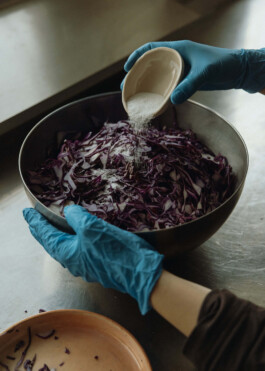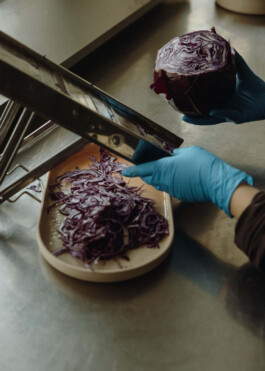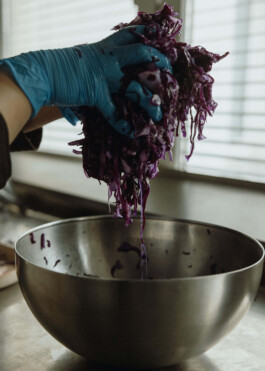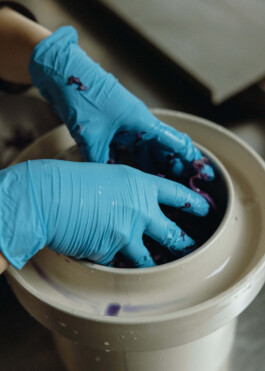
Sauerkraut
For this classic you only need 2 ingredients:
cabbage and salt.
It’s cheap, nutritious, healthy and refreshing.
You can add a variety of other ingredients to it, vegetables (like carrots or radish) or roasted seeds (like dill, caraway, coriander or mustard seeds). When ready to be served, you can enjoy it fresh or fry it.
All you need is a sharp mandoline or knife, cutting board, bowl and a jar or fermentation crock.





INGREDIENTS
Cabbage (you can use white, jaroma or red cabbage)
Salt (non–iodized, unrefined sea salt)
Optional:
Seeds and seasonings (such as dill, caraway, or coriander seeds, pepper corns, bay leaves, garlic, or dried juniper berries)
Additional vegetables (such as carrots, radish, kohlrabi)
PREPARATION
1. Start with removing the outer leaves of your cabbage and put them aside for later use. Cut the cabbage in fine pieces, either with a sharp knife or a grater / mandoline.
2. Put everything into a bowl.
3. Then: salt. You need 2 %, therefore weigh the cabbage in grams and multiply the weight by 0.02 to get the right amount. Now sprinkle the cabbage with salt, and add other seasonings if you like.
4. Squeeze the cabbage with your hands in order to release juices out of the cabbage (when the cell walls break down). Continue for a few minutes.
5. Now it’s time to pack the cabbage into a jar. Press everything down with your hands, with force, and then continue with a fermentation temper or potato masher. The cabbage should now fully be covered in brine, this is crucial.
6. Now you can put the cabbage leaves that you’ve reserved before on top of the cabbage to make sure to keep it under the brine. In the beginning of the fermentation process the vegetables have a tendency to come up to the top. You can add a fermentation weight out on top of the leaves. This will keep everything covered during the fermentation process. My grandmother used to go out and search for a suitable stone that she would later put on top of her ferment. You can use anything suitable you have at home.
7. You can put the jar in a quiet corner of your kitchen now and wait for it to become a delicious new ferment.
Enjoy!
NOTES
Keep an eye on your ferment in the first days. Push down the weight to make sure the cabbage is completely covered with the brine. This step will also release the pressure that builds up in the jar. After a week you can already enjoy the Sauerkraut, or wait about 2–3 more weeks for a stronger and more intensive taste (or longer, depending on the flavour you like).
If you want to stop or slow down the fermentation process, you can store your sauerkraut in a covered jar in the refrigerator. Depending on how much Sauerkraut you make, you can pack a weekly dose for the fridge and leave the
A pot with an airlock should avoid the formation of yeasts or molds on the surface. If you still spot some, scrape it off completely and discard, together with the upper leaves.
Brine
Do not throw away your pickle brine (any kind of pickle brine, from cabbage, capers, radishes etc.), they add great flavours to dressings and vegetables.
You can use them for deglazing (adding liquid to a hot pan, which will release the caramelized bits at the bottom of the pan).
You can deglaze with any kind of liquid, water, broth, wine and yes, pickle brine.
Sauté the vegetables, like onions and mushrooms, over medium heat. In order to use of all the flavourful caramelized bits in the pan: pour ⅓ of a cup of brine into the pan, stir and then let it reduce until ready to be served.
“90 % of the serotonin in our bodies—the neurotransmitter that when abundant makes us feel happy, and when depleted makes us feel depressed— is produced in our guts, and gut microbes play a major role in regulating its production.”
—Merlin Sheldrake, Entangled Life


Sauerkraut
For this classic you only need 2 ingredients:
cabbage and salt.
It’s cheap, nutritious, healthy and refreshing.
You can add a variety of other ingredients to it, vegetables (like carrots or radish) or roasted seeds (like dill, caraway, coriander or mustard seeds). When ready to be served, you can enjoy it fresh or fry it.
All you need is a sharp mandoline or knife, cutting board, bowl and a jar or fermentation crock.
INGREDIENTS
Cabbage (you can use white, jaroma or red cabbage)
Salt (non–iodized, unrefined sea salt)
Optional:
Seeds and seasonings (such as dill, caraway, or coriander seeds, pepper corns, bay leaves, garlic, or dried juniper berries)
Additional vegetables (such as carrots, radish, kohlrabi)
PREPARATION
1. Start with removing the outer leaves of your cabbage and put them aside for later use. Cut the cabbage in fine pieces, either with a sharp knife or a grater / mandoline.
2. Put everything into a bowl.
3. Then: salt. You need 2 %, therefore weigh the cabbage in grams and multiply the weight by 0.02 to get the right amount. Now sprinkle the cabbage with salt, and add other seasonings if you like.
4. Squeeze the cabbage with your hands in order to release juices out of the cabbage (when the cell walls break down). Continue for a few minutes.
5. Now it’s time to pack the cabbage into a jar. Press everything down with your hands, with force, and then continue with a fermentation temper or potato masher. The cabbage should now fully be covered in brine, this is crucial.
6. Now you can put the cabbage leaves that you’ve reserved before on top of the cabbage to make sure to keep it under the brine. In the beginning of the fermentation process the vegetables have a tendency to come up to the top. You can add a fermentation weight out on top of the leaves. This will keep everything covered during the fermentation process. My grandmother used to go out and search for a suitable stone that she would later put on top of her ferment. You can use anything suitable you have at home.
7. You can put the jar in a quiet corner of your kitchen now and wait for it to become a delicious new ferment.
Enjoy!
NOTES
Keep an eye on your ferment in the first days. Push down the weight to make sure the cabbage is completely covered with the brine. This step will also release the pressure that builds up in the jar. After a week you can already enjoy the Sauerkraut, or wait about 2–3 more weeks for a stronger and more intensive taste (or longer, depending on the flavour you like).
If you want to stop or slow down the fermentation process, you can store your sauerkraut in a covered jar in the refrigerator. Depending on how much Sauerkraut you make, you can pack a weekly dose for the fridge and leave the
A pot with an airlock should avoid the formation of yeasts or molds on the surface. If you still spot some, scrape it off completely and discard, together with the upper leaves.
Brine
Do not throw away your pickle brine (any kind of pickle brine, from cabbage, capers, radishes etc.), they add great flavours to dressings and vegetables.
You can use them for deglazing (adding liquid to a hot pan, which will release the caramelized bits at the bottom of the pan).
You can deglaze with any kind of liquid, water, broth, wine and yes, pickle brine.
Sauté the vegetables, like onions and mushrooms, over medium heat. In order to use of all the flavourful caramelized bits in the pan: pour ⅓ of a cup of brine into the pan, stir and then let it reduce until ready to be served.
“90 % of the serotonin in our bodies—the neurotransmitter that when abundant makes us feel happy, and when depleted makes us feel depressed— is produced in our guts, and gut microbes play a major role in regulating its production.”
—Merlin Sheldrake, Entangled Life
a pinch of salt
c/o Tamara Pešić
Ludwigstraße 197
63067 Offenbach
Germany
Pick up & drop times:
Wed, 16:00–19:00
Sat, 13:00–16:00
© Copyright 2022
a pinch of salt
c/o Tamara Pešić
Ludwigstraße 197
63067 Offenbach
Germany
Pick up & drop times:
Wed, 16:00–19:00
Sat, 13:00–16:00
© Copyright 2022